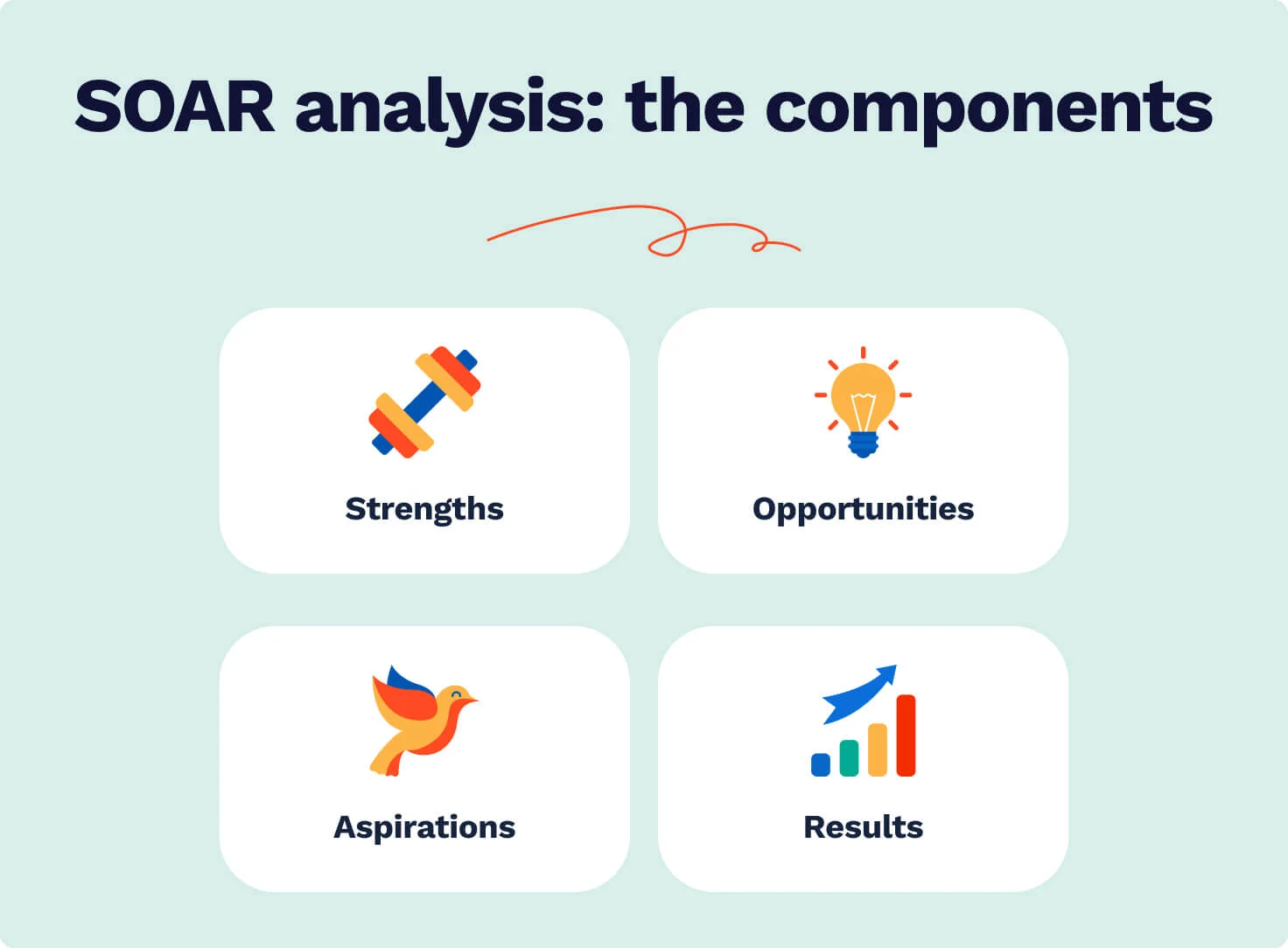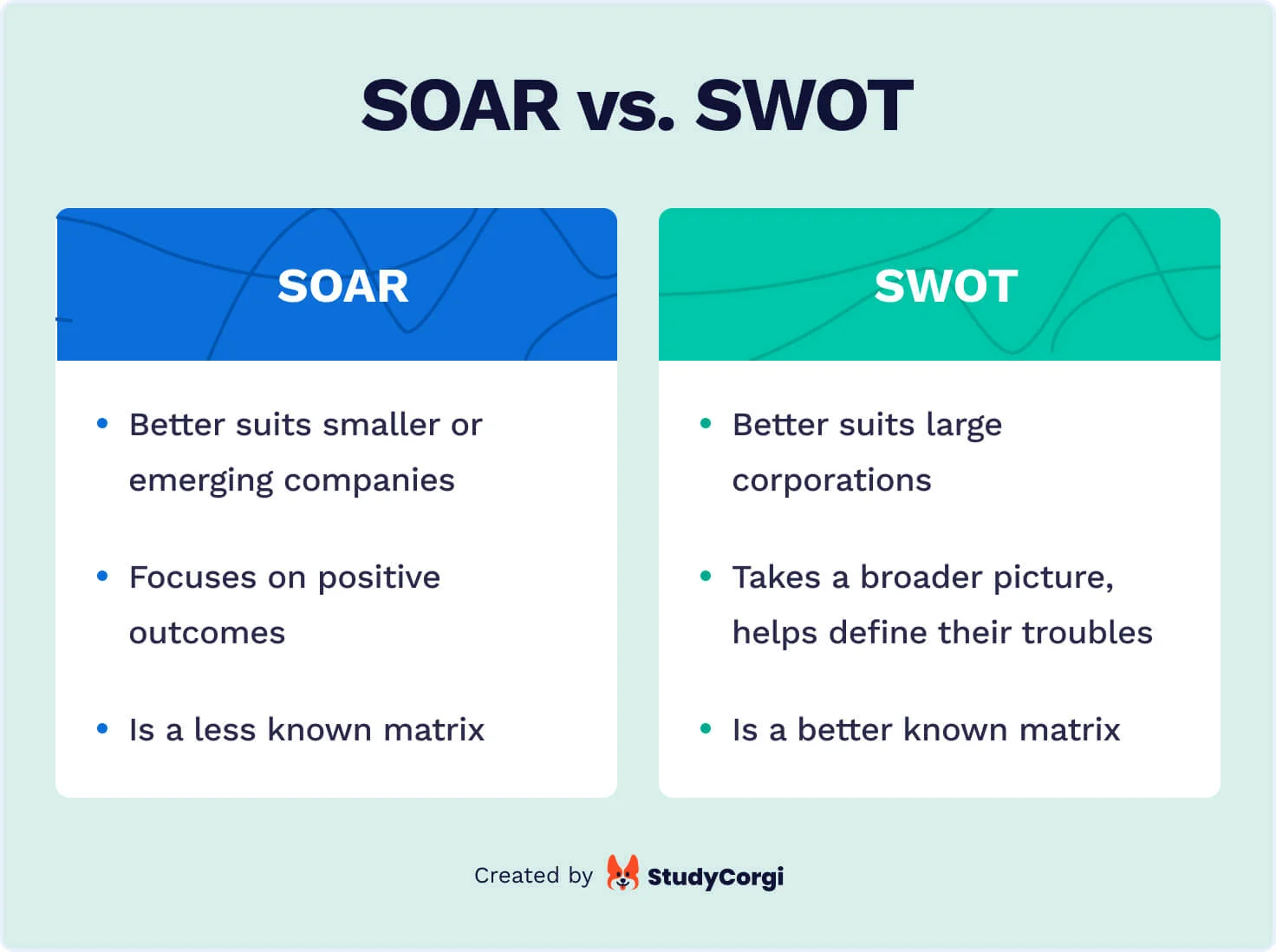📌 SOAR Analysis Matrix: How Does It Work?
- Enter the strengths, opportunities, aspirations, and results into their respective fields.
- Add more where necessary.
- Check the design preview. Try changing the layout template and color scheme.
- Download the result for free in the required file formats.
📊 SOAR Analysis Matrix Explained
This strategic planning tool analyzes the company’s strengths to build opportunities on their basis.
SOAR analysis often becomes the agenda of a team brainstorming session and provides exceptional insight into the company’s perspectives.
SOAR analysis matrix consists of the following four aspects.

Strengths
The list of the organization’s strengths should comprise the essential resources, assets, and know-how. You can define them by answering the following questions:
- What is the unique selling point (USP), i.e., something that makes your product better than any other in the market? It may bring an emotional benefit rather than material to the client. For example, if you donate 10% from each purchase to charity, it is your USP.
- What is the most critical know-how you possess? Remember, knowledge is power.
- What are the most valuable assets that give us a competitive advantage? Don’t forget about money and immovables. Having an office downtown is better than having one in the suburbs.
Opportunities
This category describes the directions promising new achievements.
The following questions will help you identify them.
- What trends in the market or the wider world could you leverage?
- Which threats could your business turn into opportunities?
- Which gaps in the market could you fill in with your product?
- Which new markets could you enter?
- Which unfulfilled wants of your customers could you meet?
Aspirations
“Would you tell me, please, which way I ought to go from here?” – “That depends a good deal on where you want to get to.”
Fairy tales reveal more life secrets than we tend to notice. The Cheshire Cat advises you to learn what your aspirations are before undertaking any actions.
- How do you vision the future of your organization?
- How can you make a difference, and what do you want to change in the world?
After all, your abilities should always meet your aspirations to fuel your progress.
Results
This category is your personal success gauge.
Here’re some questions that can establish the success milestones:
- How will you know that you’ve come where you wanted to get?
- Can you translate abstract success into measurable numbers?
- Which rates or statistics will help you to measure success?
- When and how often will you check these rates?
When to Use the SOAR Analysis?
Companies can use SOAR for the following purposes:
- Developing a new vision.
- Creating a strategic annual plan.
- Managing change.
- Launching a project.
How to Do a SOAR Analysis?
To conduct a SOAR analysis, you should follow these steps:
- Determine the problem the organization needs to address, such as a change in the organizational structure.
- Identify the company’s strengths and resources.
- Look for the opportunities that fit the organization’s strengths.
- Define the desired results and aspirations.
- Incorporate the insights gained through the SOAR analysis into the action plan to address the problem.
🆚 SOAR vs. SWOT
SOAR is a better variant for smaller or emerging companies because it focuses on positive outcomes. SWOT is a better-known matrix commonly used in large corporations to track their already-existing success and define their troubles. Meanwhile, SWOT takes a broader picture due to the precise division into internal and external factors.

📄 SOAR Analysis Example
Let’s take a chewing gum production company for a clear and memorable result.
- Strengths.
- Innovative product.
- Unique flavors.
- Opportunities.
- Get a license for using popular characters on the wrapper.
- Use paid product placement in a trending movie.
- Aspirations.
- Lead the chewing gum market.
- Gain recognition in the world population.
- Results.
- Raised sales by 50%.
- 30% of recognition in public surveys.
Thank you for reading this article! If you are interested in other business analysis options, consider trying our VRIO, PESTEL, and Porter’s 5 Forces analysis makers.
Updated: